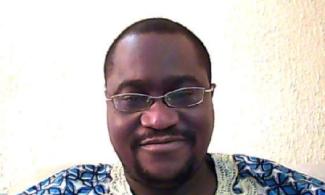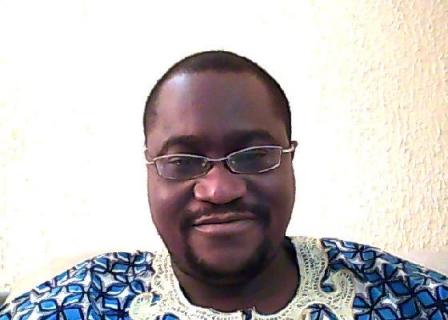
Both SWAFP and the NLP would be smashed by the military juntas (first of General Aguinyi Ironsi's for just 6 months but more so by General Yakubu Gowon's which lasted 9 years), as all partisan formations were repressed. But the tendency they had formed would continue in different forms (as well as SWAFP's till the early '90s) till the early 2000s.
Today makes it twenty-one years since Comrade Ola Oni passed on. He was one of the greatest leaders and teachers on the Nigerian Left, from the '60s till his death. He, along with Eskor Toyo, Baba Omojola and others split from the Socialist Workers and Farmers Party in Augsut 1964 (i.e., a year and four months after SWAFP was formed) to form the Nigeria Labour Party under the leadership of Michael Imoudu (Labour Leader #1).
Both SWAFP and the NLP would be smashed by the military juntas (first of General Aguinyi Ironsi's for just 6 months but more so by General Yakubu Gowon's which lasted 9 years), as all partisan formations were repressed. But the tendency they had formed would continue in different forms (as well as SWAFP's till the early '90s) till the early 2000s.

With elections on the horizons for the establishment of a Second Republic in 1979, a series of two All-Nigeria Socialist Conferences were organised in 1977 and 1978, with the primary aim of forming a united socialist party. That aim was not achieved. Two parties emerged - both were never registered. And many others ended up on an entryist basis in some of the reformist parties that emerged, particularly the social-democratic UPN and GNPP and the radical reformist PRP.
The two unregistered socialist parties were the Socialist Working People's Party (a reincarnation of SWAFP) and the Socialist Workers, Poor Farmers and Youth Party (simply SWP as acronym), with Ola Oni as its leader.
SWP's Labour Education and Research Centre (similar to, but with a more clearly working-class thrust than the the earlier Nigerian Academy of Arts, Science and Technology which the trend had run in the 1970s after dissolution of the NLP) conducted several forms of educational activities for workers.
It was also a major centre for student activists to get involved in working-class education and organising work. These included the comrades from University of Ife and The Polytechnic who would form the Trotsyist Labour Militant in the mid-1970s.
The mid-80s did not only witness the foundations of lasting Trotstyist politics on the Nigerian Left (an earlier effort in the 60s had floundered). It was actually a period of reconstitution of the Nigerian socialist left.
The Marxist-Leninist Left coalesced into two groups: the Socialist Congress (SCON, or simply SC) and eventually the Socialist Revolutionary Vanguard (SRV led by Ola Oni). It is to Oni's credit that whilst the SWAFP/SWPP trend fell off the cart at this turn around an historic corner, he kept the torch of continuity of his trend alive (albeit or rather with the drawing in of new, and at that time not so new - i.e., from the 70s as where the SC leading comrades - generation).
(Comrades from the SWAFP/SWPP heritage did try to regroup at the turn of the century as a Communist Party of Nigeria (COMPON) with barely a dozen cadres. These were fine revolutionaries no doubt. They had all passed through the firm organising hand of Wahab Goodluck (the leader of the SWAFP/SWPP trend along with Ibidapo Fatogun and S.U. Bassey). But, unlike Ola Oni’s trend, they had not been able to regenerate cadreship.
The death of Ibrahim Yusuf the COMPON Chair a few years back marked what was effectively the beginning of the end for an attempt to find a new beginning for that trend. And the painful loss this year, first of AbdulKareem “Xmakad” Motajo & then Joel Emereole might have sealed this.)
The 1990s was also a defining decade. The storm of struggle after the annulment of the “June 12”
presidential election led many on the Left to ethno-nationalist politics. This, arguably started with Yoruba comrades in the south-west (O’odua Youth Movement, 1994; O’odua Peoples Congress, 1995; O’odua Liberation Movement, 1996 & YOREM, 1999) and then the Niger Delta (Pan-Niger Delta Resistance Movement – Chikoko Movement -, 1997 & Ijaw Youth Council, 1998).
Ola Oni was swept into this turn, becoming head of the Apapo Egbe omo O’odua (Coalition of -Left- O’dua groups). In the funeral oration I delivered on behalf of the Medical and Health Workers’ Union of Nigeria as we paid our last respects to him, I pointed out our reservation at this. It is however important not to take this last act in a very eventful revolutionary life as a denouement of class politics.
For Oni as with some of those on the Left who swung to this kind of nationalist politics, it was about addressing the national question frontally as an important aspect of the broader social question of class politics. I don’t agree with this.
But it is to Ola Oni’s eternal credit that, unlike many who got rich through O’odua politics (which enabled alliances with the Yoruba bourgeois and with it the flowing in of hundreds of millions of naira, from Ilorin and Alausa for example), he chose not to benefit materially. One can’t deny that he acted on a principled basis, and not one of self-aggrandisement, even as one can equally argue that this principle could be considered flawed.
I think that turn for him represents a furtherance of entryism raised beyond tactic to a more strategic level. He had carried out entryism in the bourgeois social-democratic UPN when SWP was not registered, in the early 1980s.
The entrance of hundreds of thousands of people into the struggle on a Yoruba ethnicist basis inspired many comrades in the south-west as a to see ethno-nationalist politics as a short-cut to massifying the movement for socialism in the long run whilst addressing the national question in the short-term.
It was thus seen as entryism not in the traditional sense of work in a party or organisation, but of work in the Yoruba self-determination movement with Left organisations which then wittingly or unwittingly ended up in class collaboration with the bourgeois.
As we remember Ola Oni today, I think great attention should be paid to preserving his monumental legacy. His home and bookshop at 6 Odeku Close was for several decades both home and the primary source for radical and revolutionary literature for many, if not most of us on the Left. The house now holds manuscripts of Baba Oni and invaluable records of meetings and movements.
His son, Tunde Oladapo Oni has tried, with the help of a few comrades like Dr Sola “Sola Mike” Olorunyomi to preserve these, including with digitalisation. But they are still not in the best of shape. A fire sometime back has also resulted in the loss of some of these materials, while the Comrade Ola Oni Centre for Social Research established in Osogbo when Rauf Aregbesola was governor has not really been of much help, to the best of my knowledge.
I am strongly of the view that comrades need to take the preservation of these materials, and indeed the wealth of materials being lost as we lose the great minds and leaders of our movement, as a project. I would suggest we task ourselves with work over the next four years to have this done, toward commemorating a quarter of a century of the exit of the great teacher and leader that Comrade Ola Oni was.
We must celebrate our s/heroes. Their labours must not be in vain. Their legacies must be kept alive, and not just as mummified relics, but preserved in ways and manners that help nourish the struggles of today and generations to come, in the struggle for and building of socialism.